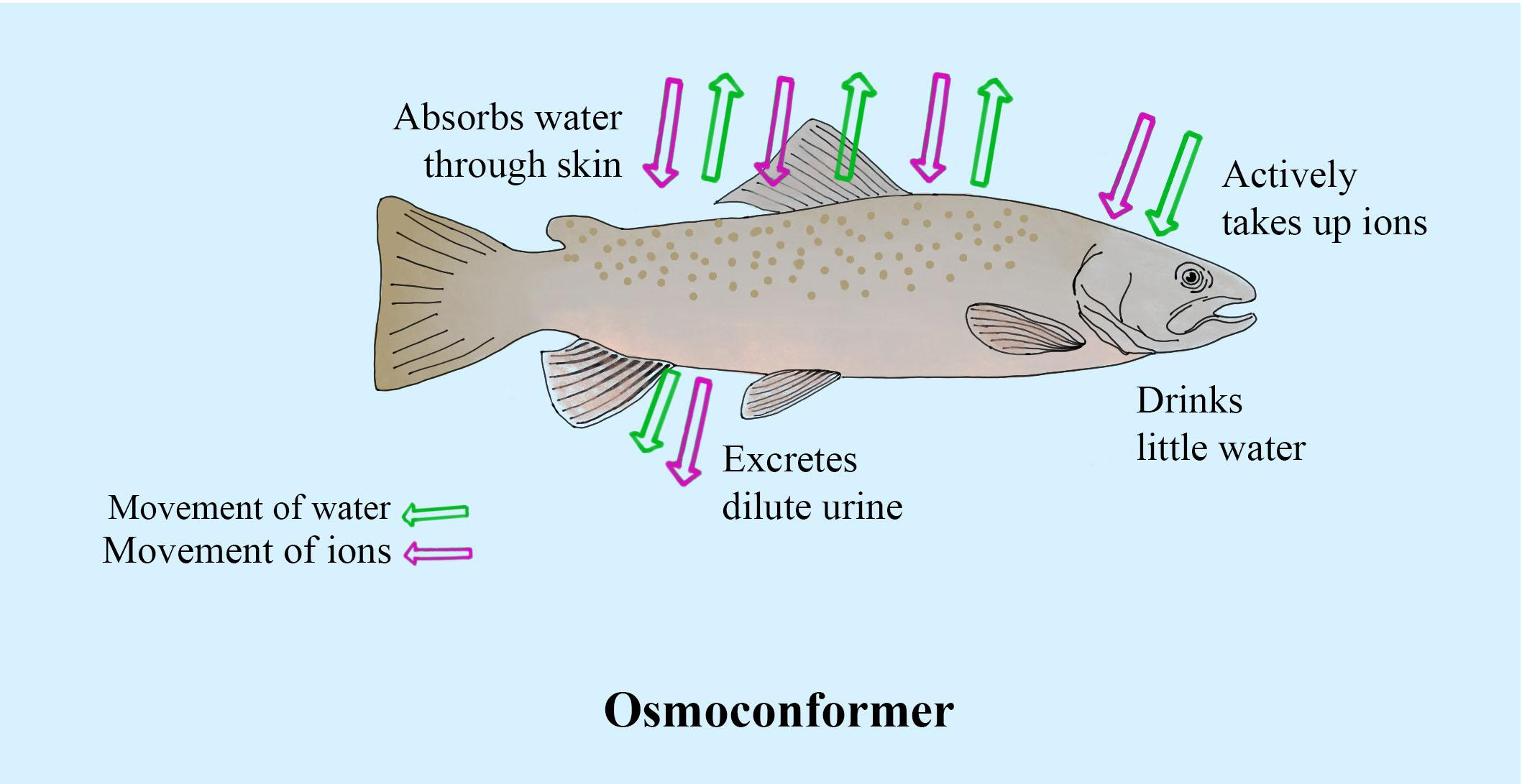
Osmoconformer are animals that
(a) Do not actively control the osmotic condition of their body fluid so are stenohaline
(b) Actively control the osmotic condition of their body fluid
(c) Are also called euryhaline
(d) Do not change the body fluid according to the osmolarity of the ambient medium
Answer
567.9k+ views
Hint: It is an organism that keeps its internal fluids isotonic to their environment, that is, they maintain an internal salinity similar to their ambient conditions (e.g., most marine invertebrates, seagrass). It balances ions and water in unique and fascinating ways.
Complete answer:
Generally, it is marine animals, which keep up the osmolarity of their body fluid, with the end goal that it is consistent equivalent to the encompassing seawater. Osmoconformers decline the net flux of water into or out of their bodies from diffusion. It can maintain the internal solute concentrations within their bodies at a level that is equal to the osmolarity of the surrounding medium. They do not need to expend as much energy as the osmoregulatory to regulate the ion gradient.
Additional Information:
Osmoconformers coordinate their body osmolarity to their environment actively or passively. Most osmoreceptors are marine invertebrates, although it is observed that their ionic composition is different from that of seawater. In the animal kingdom, osmoregulatory firmly regulates their body osmolarity, which consistently stays constant. The osmoregulatory will effectively control salt concentrations notwithstanding the salt concentrations in the environment. An example is a freshwater fish.
Euryhaline organisms, organisms like the salmon and molly that can tolerate a relatively wide range of salinity. The stenohaline is a freshwater organism and it will die in seawater, and in a similar way, most marine organisms are stenohaline, and can’t live in freshwater.
So the correct answer is ‘Do not actively control the osmotic condition of their body fluid so are stenohaline’.

Note: Most of the marine are invertebrates, then again, perhaps isotonic with seawater (osmoconformers). Their body fluid concentrations adjust to changes in seawater concentration. Cartilaginous fishes’ salt composition of the blood is similar to bony fishes; Although, the blood of sharks contains the organic compounds urea and trimethylamine oxide (TMAO).
Complete answer:
Generally, it is marine animals, which keep up the osmolarity of their body fluid, with the end goal that it is consistent equivalent to the encompassing seawater. Osmoconformers decline the net flux of water into or out of their bodies from diffusion. It can maintain the internal solute concentrations within their bodies at a level that is equal to the osmolarity of the surrounding medium. They do not need to expend as much energy as the osmoregulatory to regulate the ion gradient.
Additional Information:
Osmoconformers coordinate their body osmolarity to their environment actively or passively. Most osmoreceptors are marine invertebrates, although it is observed that their ionic composition is different from that of seawater. In the animal kingdom, osmoregulatory firmly regulates their body osmolarity, which consistently stays constant. The osmoregulatory will effectively control salt concentrations notwithstanding the salt concentrations in the environment. An example is a freshwater fish.
Euryhaline organisms, organisms like the salmon and molly that can tolerate a relatively wide range of salinity. The stenohaline is a freshwater organism and it will die in seawater, and in a similar way, most marine organisms are stenohaline, and can’t live in freshwater.
So the correct answer is ‘Do not actively control the osmotic condition of their body fluid so are stenohaline’.

Note: Most of the marine are invertebrates, then again, perhaps isotonic with seawater (osmoconformers). Their body fluid concentrations adjust to changes in seawater concentration. Cartilaginous fishes’ salt composition of the blood is similar to bony fishes; Although, the blood of sharks contains the organic compounds urea and trimethylamine oxide (TMAO).
Recently Updated Pages
Master Class 11 Business Studies: Engaging Questions & Answers for Success

Master Class 11 English: Engaging Questions & Answers for Success

Master Class 11 Computer Science: Engaging Questions & Answers for Success

Master Class 11 Social Science: Engaging Questions & Answers for Success

Master Class 11 Maths: Engaging Questions & Answers for Success

Master Class 11 Biology: Engaging Questions & Answers for Success

Trending doubts
One Metric ton is equal to kg A 10000 B 1000 C 100 class 11 physics CBSE

Explain zero factorial class 11 maths CBSE

An example of chemosynthetic bacteria is A E coli B class 11 biology CBSE

State the laws of reflection of light

Name the metals and nonmetals in the first twenty class 11 chemistry CBSE

What is 1s 2s 2p 3s 3p class 11 chemistry CBSE




